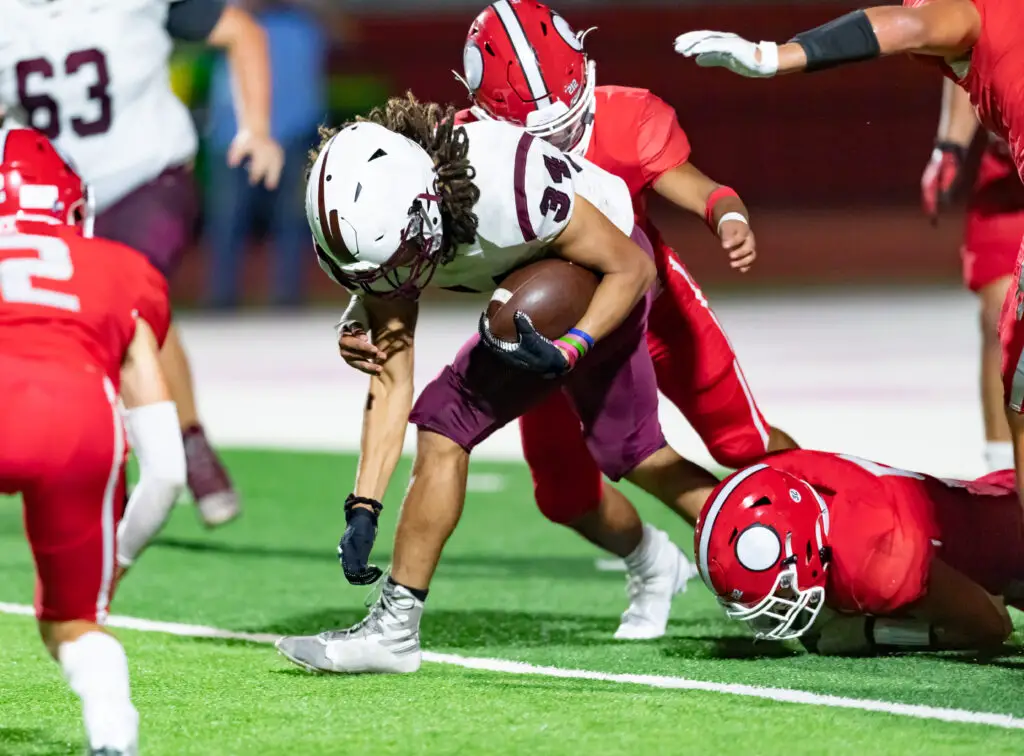Only a few years ago a shovel pass was something you would rarely see in football. But due to the fast-changing offenses of the NFL the shovel pass has become a popular play.
A shovel pass in football is a short pass that is thrown with a pushing motion or underhand toss. Despite their short distance, these throws are considered a forward pass and a completion for the quarterback.
These passes are only in the air for one or two yards, making them not so different from a handoff. The throwing motion on a shovel pass often referred to as a shuffle pass is very similar to the throw of lateral. The main difference being that a shovel pass travels forwards and a lateral travels backwards.
Both of these throws are completed by an underhand tossing motion or by pushing the ball out with a single hand.
What Does A Shovel Pass Look Like?
Now that you know what a shovel pass is it’s time you see some examples. In the video below you will see how some football teams have utilized the shovel pass in their offense. Though not included in the video below you should know that this is not always a designed play.
Though most shovel passes are planned, on some plays quarterbacks are forced to throw a shovel pass in desperation.
Is A Shovel Pass A Completed Pass?
Yes, despite the very small distance travelled a shovel pass is a completed pass. Since the ball leaves the quarterbacks hands, is then airborne, and travels forwards it meets all the requirements for a forward pass.
Since this is a completed pass, the quarterback is going to receive passing yards for each yard the ball carrier travels after the catch once past the line of scrimmage.
But does it count as a touchdown pass? The answer is yes despite only throwing the ball a short distance a these shovel passes still count as a touchdown pass.
Who Invented It?
Western Maryland quarterback Eugene “Stoney” Willis is considered the first player to use a shovel pass in a football game. Since this throw is a fairly natural way to throw a short pass he likely was not the only quarterback to throw the ball in this manner.
Either way, Stoney Willis was the first player to use this throw in a large-scale game. This first shovel pass was thrown in November 12, 1932 against Boston College.
Is it shovel pass or shuttle pass?
For whatever reason, the term shovel pass is often misheard shuttle pass or shuffle pass. The correct term is shovel as you are shovelling the ball towards your teammate. This name was chosen based on the throwing motion that comes with this pass.
Another common misconception of this term is shuffle pass. Similar sounding football terminology like this can be confusing.
To be clear the correct term is shovel pass not shuttle pass or shuffle pass. This can be easily remembered by thinking of the term shoving as in to push something roughly. A shovel pass is essentially a rough push on the ball.
Which Positions Catch Shovel Passes?
Now that we’ve broken down exactly what a shovel pass is in football it’s time to get into who catches these passes. Shovel passes are relatively rare but designed plays can get these passes in the hands of several different skill positions.
Running Backs
Running backs are the most likely receiver on the end of these passes. Since these passes are short players in close proximity to the quarterback are the most likely to receive them.

One play in which a running back may receive a shovel pass occurs when he runs in a sweep motion across the formation. Though instead of handing the ball off to this player the quarterback will toss the ball a few inches forward and it is caught by the running back.
The running back will then continue across the formation for a run outside the tackle.
Tight Ends
Tight ends are another skill position that may find themselves on the receiving end of one of these short passes. Since these players often line up just outside the tackle they are quite close to the quarterback.
On plays in which they may catch one of these passes, they will usually start the play on the outside of the formation and work their way inwards.
In the video posted earlier in the article, you can see a tight end move inside across the formation to catch the short pass and take it to the endzone.
Tight ends may also catch these passes on screen plays. Tight ends may get screen plays in which they catch the ball close to the line of scrimmage.
Due to their close proximity to the quarterback, a shovel pass is sometimes the best way to get the ball in the tight end’s hands.
Wide Receivers
The wide receiver position is another that may catch a few of these short shovel passes from time to time. Since wide receivers tend to line up much too far from the quarterback for a shovel to be completed they need to be in motion to catch one.
When a receiver is in motion he can move laterally across the field before the ball is snapped. Receivers may come in a jet sweep motion from the slot or outside all the way to the middle of the field and receive the shovel pass from the quarterback.
These sorts of plays can be life savers for game manager quarterbacks who rely on short passes like shovels in order to move the ball down the field.
That is all on the shovel pass in football if you want to learn some other throwing techniques see our guides to quarterback touch passes or the faster bullet pass.

